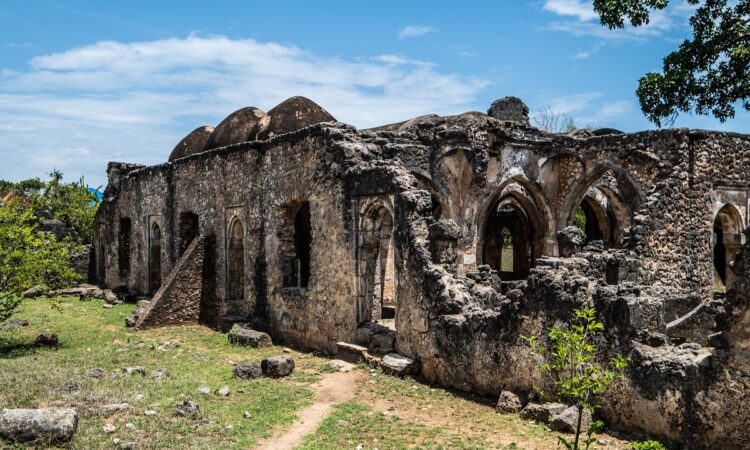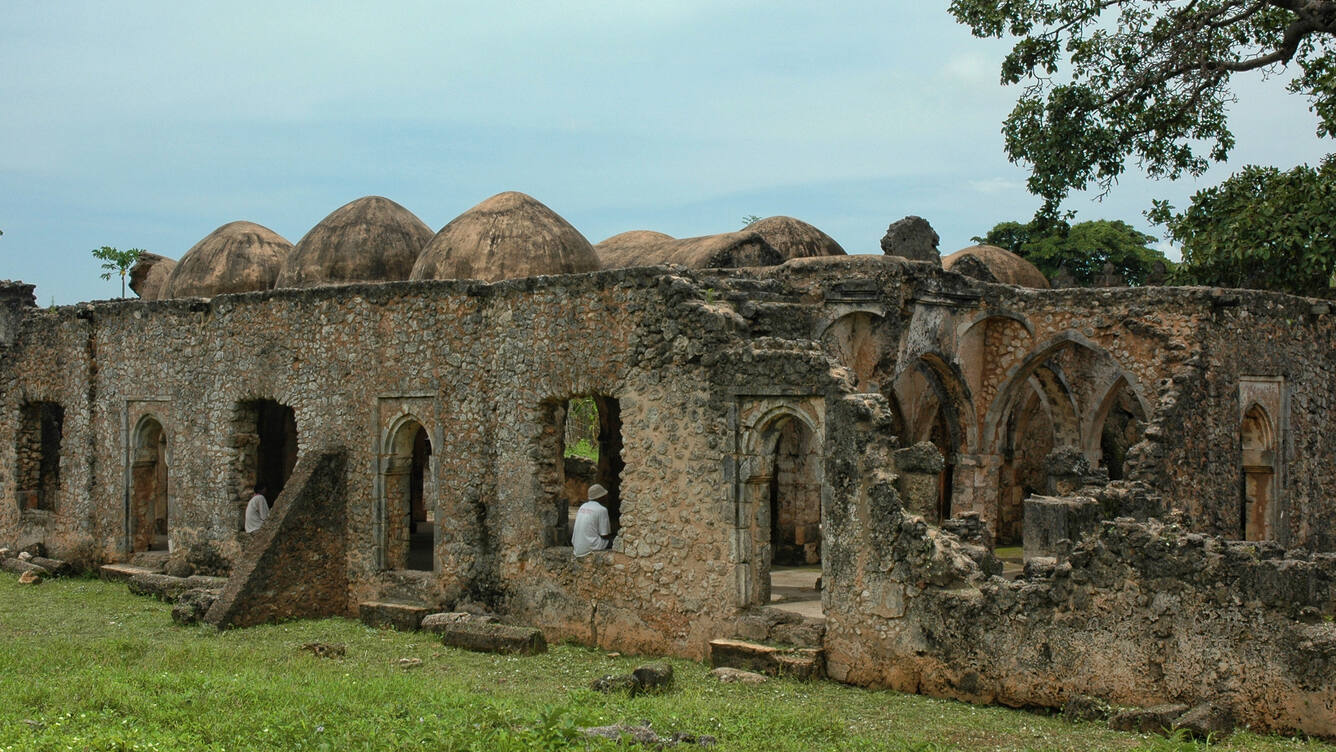The Archeological Site of Kilwa Kisiwani: Kilwa Kisiwani is an old island situated about nine kilometers off the southern Tanzanian coast that finds itself in the history books and folklore tales. Kilwa Kisiwani was one of the greatest and most prosperous trading cities in eastern Africa on the Swahili Coast and it turned into a site of breathtaking ruins. Kilwa Kisiwani considered a UNESCO World Heritage Site holds the sociopolitical significance and a history of the architectural skills and prowess, trade and commerce as well as the cultural heritage of the early inhabitants of this part of the region.

Kilwa Kisiwani history
Kilwa Kisiwani which means Kilwa of the Island was established in 900 AD by Persians from Shire. Over many years it grew to become one of the most prosperous city-states along the Swahili coast, its golden age would be considered to have been between the 13th and the 16th century. Its favorable geographical position on the coast of the Indian Ocean made it a center of trade between Africa, Arabia, Persia, India, and China.
The source of wealth for Kilwa Kisiwani was trade in gold, ivory people, and other products such as timber and spices produced in the region. Kilwa’s rulers dominated the gold trade routes from the Zimbabwean plateau to the coast, and the city became very prosperous and was people by many traders and settlers from all parts of the region. These people and their goods introduced to the region and the intermediary community breathed cosmopolitan culture of African, Arab, Persian, and Indian origin in the formation of the Swahili culture existing in the region up to the present time.
Kilwa Kisiwani and its Wonders of Architecture
Remains of Kilwa Kisiwani can be described as spectacular examples of Swahili architecture – the building style that uses coral stone and lime mortar and is easily distinguished by elaborate carvings and intricate design. Mosques, palaces, and residents’ buildings have been built on the island, and all the structures show the richness of the inhabitants of the city.
- The Great Mosque of Kilwa:
The Great Mosque of Kilwa is one of the most important buildings in the area and is in fact believed to have been built in or before 900 AD, which makes it one of the oldest mosques still in existence on the East African coast. Consecrated in the 11th century and restored in the 14th century the mosque is a structure that captures Swahili Islamic architecture at its best. The mosque has a large prayer hall with a dome and a variety of rounded massive stone columns, which gives an inspiring, at the same time, massive-looking interior. Coral stone and carved doorways and windows are also incorporated and adorned by the expertise and artistic ability of Swahili construction workers.
- Husuni Kubwa:
Another archaeological sight of interest on Kilwa Kisiwani is known as Husuni Kubwa, which literally translates into ‘The Great Fort’. Husuni Kubwa was constructed in the early part of the fourteenth century and forms the greatest Kilwa architectural monument: it was the grand royal palace of the Sultan of Kilwa and was a clear manifestation of the comparative prosperity of the city. The architectural ensemble includes a number of yards, terraces, and rooms as well as one of the largest pools in central Asia at the time that might have been used for ritual bathing. What we can see in the architectural design of Husuni Kubwa is also the influence of Swahili and Middle East aesthetics typical for Kilwa: for instance, the building contains arcades, vaulted chambers, as well as various ornaments.
- The Gereza Fort:
Gereza Fort built during the early 16th century by the Portuguese remains as evidence of the dynamism of the history of the Kilwa Kisiwani. The fort was built after the Portuguese had seized the island in 1505 in order to fortify their rule and secure their commercial stakes. Fortifications consisted of coral stone walls and defensive towers in accordance with the military architecture of the epoch which, together with the construction, signaled the beginning of the degeneration of Kilwa as the Portuguese upset the existing trade, and subjugated the region to their control.

What led to the fall of Kilwa Kisiwani’s Economy?
Kilwa Kisiwani therefore began to decline in the middle of the 16th century when the Portuguese arrived. Since the time of Kilwa’s rise to prominence, its economy depended on long-distance trade, and Portuguese conquest and colonization of the island upset established trading patterns. Therefore the city lost its wealth and also the authority it used to exercise. Through the 16th – early 18th centuries the island was captured and recaptured several times, and in the 18th century, it was claimed by the Omani Arabs again, albeit for a brief period, and the island never again returned to the height of its prosperity.
Kilwa Kisiwani became nearly deserted in the 19th century, and the great city that had once been the centre of life there was no more. Due to its grim tropical environment, and the invasion of vegetation on the buildings; some of them became dilapidated with time. However, Kilwa Kisiwani continued to be a historical locale as explorers, archeologists, and historians visited the area in order to bring out the unknown facts about this place and save that information for future generations.
Rediscovery and Preservation Efforts
With the new imperialists from Europe in the 19th and 20th centuries, exploring and archeology saw the site of Kilwa Kisiwani as rich in history. Several tours were made to take photographs and to dig with a view to assessing the level of architectural and artistic impress that Kilwa possessed.
Kilwa Kisiwani, together with the adjacent Songo Mnara ruins, for instance, was listed as a World Heritage site in 1981 consequent to the discovery of its cultural significance. This gave people recognition of the need to maintain, protect, and preserve the ruins as they continued to deteriorate.
Over recent years, several conservation measures have been deployed to ensure that the ruins of Kilwa Kisiwani are conserved. Some of the undertaken activities have involved Intensive repairs on structures, removal of vegetation to free access areas, and the placement of visitor facilities for ecological tourism. Local people have also participated in these conservation activities since they understand the value of cultural sites and the possibility of tourism as a source of income.
Visiting Kilwa Kisiwani Today
Nowadays Kilwa Kisiwani is one of the most popular tourist attractions for individuals, who are keen on the history, archeology, and culture. The archaeological sights in the island present the tourists with an opportunity to time-travel to Kilwa to early 14 century when the city was a powerful and growing commercial hub.
Conclusion
The Archeological Site of Kilwa Kisiwani therefore stands as a symbol of the forgotten entities of the island’s calendrical culture. Kilwa Kisiwani therefore used to be among the most important centers of the East African coast that formed part of the heyday of Swahili civilization. Now, it is an empty space that encourages people to come and visit and learn about the architectural, economic, and cultural history of this phenomenal city-state.
Through a visit to the island of Kilwa Kisiwani tourists will be given a view of this history as well as be in a position to indirectly support the conservation of this extraordinary cultural, historical, and geographical asset.


